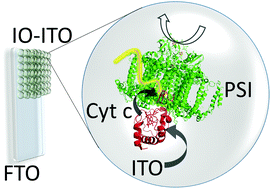A precursor-approach in constructing 3D ITO electrodes for the improved performance of photosystem I-cyt c photobioelectrodes†
Abstract
In recent years the use of photoelectrodes based on conductive metal oxides has become very popular in the field of photovoltaics. The application of 3D electrodes holds great promise since they can integrate large amounts of photoactive proteins. In this study photosystem I (PSI) from the thermophilic cyanobacterium Thermosynechococcus elongatus was immobilized on 3D ITO electrodes and electrically wired via the redox protein cytochrome c (cyt c). The main goal, however, was the investigation of construction parameters of such electrodes for achieving a high performance. For this, ITO electrodes were constructed from liquid precursors resulting in improved transmission compared to previous nanoparticle-based preparation protocols. First, the doping level of Sn was varied for establishing suitable conditions for a fast cyt c electrochemistry on such 3D electrodes. In a second step the pore diameter was varied in order to elucidate optimal conditions. Third, the scalability of the template-based preparation was studied from 3 to 15 layers during spin coating and the subsequent baking step. In the thickness range from 3 to 17 μm no limitation in the protein immobilization and also in the photocurrent generation was found. Consequently, a photocurrent of about 270 μA cm−2 and a turnover number (Te) of 30 e− s−1 at PSI were achieved. Because of the high current flow the withdrawal of electrons at the stromal side of PSI becomes clearly rate limiting. Here improved transport conditions and alternative electron acceptors were studied to overcome this limitation.



 Please wait while we load your content...
Please wait while we load your content...